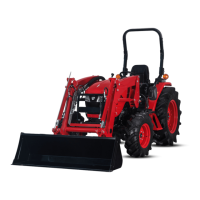
Do you have a question about the TYM 3620 and is the answer not in the manual?
| Engine Type | Diesel |
|---|---|
| PTO HP | 27.7 hp |
| 3-Point Hitch Category | I |
| Weight | 2, 469 lbs |
| Fuel Tank Capacity | 8.7 gal |
| Brakes | Wet Disc |
| PTO Speed | 540 RPM |
| Hydraulic Remotes | 1 |
| Steering | Power steering |
Explains the meaning of various symbol marks used on the tractor controls.
Environmental policies regarding product use and disposal.
Essential guidelines for safe tractor operation and handling.
Specific safety instructions for operating the tractor during work.
Safety measures for storing the tractor for extended periods.
Instructions on how to properly maintain safety decals on the tractor.
Details on how to obtain after-sales service and support for the tractor.
Importance and recommendation of using genuine TYM parts and fluids.
Detailed technical specifications for different tractor models.
Information on the tractor's various driving speeds and ranges.
Identification of external parts and the Roll-Over Protective Structure.
Explanation of cabin controls, switches, and levers for operation.
Description of gauges, indicators, and warning lamps on the instrument panel.
Explanation of pedal and lever operations for driving and implement control.
Importance of seat belt and Roll-Over Protective Structure for safety.
Daily inspections, pre-operation checks, and engine starting procedures.
Instructions on proper driving, turning, and slope operation.
Guidelines for attaching, handling, and using tractor implements safely.
Instructions on how to fold and unfold the Roll-Over Protective Structure.
Recommended maintenance intervals and tasks based on operating hours and time.
Specifications for engine oil, grease, and anti-freeze types.
Procedures for checking and changing the engine oil.
Instructions for replacing engine oil, transmission, fuel filters, and coolant.
Checking and adjusting the brake pedals for proper function and free play.
Common engine problems, inspection items, and corrective actions.
Diagnosing and resolving issues with the tractor's hydraulic system.
Troubleshooting common electrical system faults and lamp issues.
Guidelines for preparing and storing the tractor for extended periods.
Recommendations for environmentally responsible usage and disposal of fluids.
Details of the U.S. EPA emissions control warranty rights and obligations.
